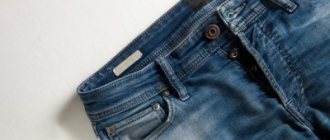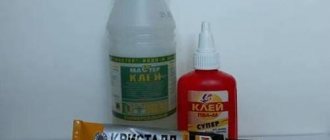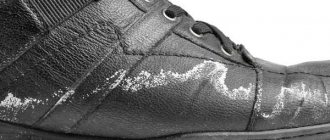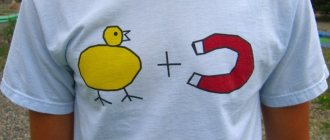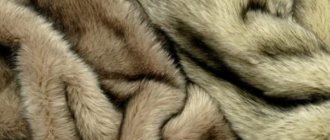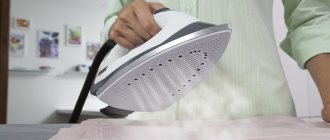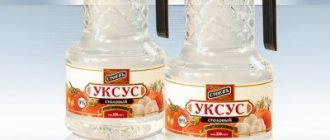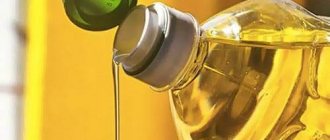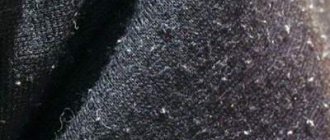Chlorine bleach stains are a special type of stain that cannot be removed by regular washing.
Contacting fabric fibers, Whiteness discolors them, leaving white (and in some cases yellow) stains.
The problem of Whiteness stains can be solved only by restoring the color of the damaged area. Proven methods and recommendations from experienced housewives will help you do this correctly.
We will tell you further how to remove Whiteness stains from white, black and colored ones.
What to do first?
The first thing to do when bleach gets on your clothes is to neutralize the effect of bleaching agents as soon as possible.
To do this, you need to carry out the following manipulations:
Thoroughly rinse traces of Whiteness on the fabric under running water. The goal is to rinse as much bleach out of the fibers as possible.- Without twisting the fabric, sprinkle a thick layer of baking soda on the stain. The goal is to neutralize the bleaching effect of Whiteness.
- Leave the layer of soda on the clothes until completely dry, then remove the powder with a soft brush.
It is necessary to begin neutralizing traces of bleach as soon as the bleach gets on the clothes. Delaying the process significantly reduces the chances of removing stains and restoring the original appearance of the clothing.
How to remove from white?
As strange as it may sound, Whiteness actually leaves stains on white fabric. These yellow stains are nothing more than traces of colored substances included in the bleach. There are several ways to restore the original whiteness of a damaged item.
Folk remedies
Hydrogen peroxide will help lighten yellow white spots on white fabric . Simply wipe the stain thoroughly with a cotton pad soaked in peroxide.
Aspirin can also solve the problem of old stains from whiteness on white fabric. It is necessary to treat contaminants with a special paste.
To prepare it, two Aspirin tablets are ground into powder and diluted to a paste with warm water. Three hours after treatment, the item is washed as usual.
Household chemicals
Stain removers will help remove yellow stains from white fabric. TOP 3 best anti-stain products for white things:
Vanish Gold Oxi Action Crystal White
Removes any dirt (including whiteness) without any residue. Clothes with stains are soaked in water with dissolved bleach powder (the proportion indicated by the manufacturer on the label) for at least an hour. Afterwards the items are washed as usual.
Active oxygen and enzymes in the bleach do not damage the structure of the fibers. The average cost is 1000 rubles. (weight 1000 g). Read reviews here, here and here.
Clean Home Express effect
Environmentally friendly bleaching powder will clean clothes from stubborn and stubborn stains. Active oxygen in the stain remover enhances the effect of the washing powder. Compatible with any detergent. The average cost is 600 rubles. (weight 1000 g). Read reviews here, here and here.
Frosch
Stain pre-treatment agent, stain remover from a German manufacturer. The main component - citrate salt of citric acid - will quickly remove stains and yellowness from snow-white things. Suitable for all types of fabrics. The average cost is 160 rubles. (volume 750 ml). Read reviews here, here and here.
Before using any chemical composition, it must be tested on an inconspicuous area of clothing.
Clue
If you need to boil your jeans to a more or less uniform white color, you don’t need to twist them into a rope, just put them in boiling water with bleach. Monitor the cooking process very carefully, regularly turning the jeans in the pan with a wooden stick so that the water and bleach can flow into each fold.
Finally, the transition points between a darker shade and a lighter one can be rubbed with a stiff clothes brush to give the item an even more stylish, worn look.
If a yellow bleach stain has formed on your white jeans, you can also try to remove it by treating it with one of the following products:
- ordinary household stain remover;
- hydrogen peroxide;
- powdered acetylsalicylic acid tablets (pharmaceutical Aspirin), diluted to a thick paste with water;
- paste of baking soda and water.
After applying any of the above products to the damaged area, the item should be allowed to sit with it for 20-30 minutes. Then rinse and wash as usual. If necessary, repeat the procedure.
How to remove from black?
Whiteness leaves white spots on black fabric, which can only be hidden by painting. For such purposes, special dyes are used (available in an assortment on the shelves of hardware stores or in handicraft departments).
Algorithm of actions:
- the dye selected by color is dissolved with water (the exact instructions are indicated by the manufacturer on the label);
- the product spoiled by Whiteness is dipped into the resulting solution and brought to a boil (it is important not to exceed the soaking and boiling time indicated on the label);
- The painted item is rinsed in cold water with vinegar (2-3 teaspoons of vinegar per liter of water is enough).
TOP – 3 best dyes for black fabrics:
IDEAL Back to Black
Ideal for restoring black fabrics damaged by chlorine bleaches. Suitable for all types of fabric. After dyeing, clothes do not fade. The average cost is 680 rubles. (weight 400 g). Read reviews here.
Simplicol Intensiv clothing dye
Will evenly color areas of black clothing bleached by White. Suitable for natural and synthetic fabrics. Simply place clean items in the washing machine, add a packet of liquid dye, and start the wash at 4°C. No need to add powder. After dyeing, clothes do not fade. The average cost is 650 rubles. (weight 400 g). Read reviews here.
Marabu fabric dye
Suitable for both manual and machine dyeing . The restored color does not fade and is resistant to frequent washing. The dye is suitable for all types of fabrics. The average cost is 560 rubles. (package 30 g).
Painting with professional paints is carried out strictly in accordance with the manufacturer's instructions.
When you don’t have time to search for special paints, mascara will help to disguise white spots on black fabric. It penetrates deeply into the fibers, permanently coloring discolored areas in a rich black color (the effect persists even after washing).
How to eliminate on color?
The easiest way to restore the brightness of colors in discolored areas of colored clothing is to use special permanent markers.
Among the wide range of markers presented on the shelves of haberdashery stores, everyone will be able to find the option they need. The main thing is to choose the right marker color that matches the tone of the damaged fabric.
If the colored fabric is slightly damaged, alcohol will help to mask traces of whiteness. To do this, moisten the outline of the stain with a cotton swab, generously moistened with alcohol. After a few minutes, carefully using a cotton swab, the coloring pigment softened with alcohol is redistributed over the whitish spot from the Whiteness. This method is most effective for fabrics with unstable dyeing.
Features of removal depending on the type of material
One of the factors that influences the choice of method for removing bleach stains is the type of fabric from which the clothing is made.
Jeans
Whiteness stains on denim can only be removed by masking. Small spots are painted over with a pen or felt-tip pen. In cases where Whiteness has damaged a significant area of a denim product, boiling it down will help to revive it.
Algorithm of actions:
The damaged denim item is twisted (alternatively, the fabric can be pulled together with a rope and tied in a knot).- In a very large saucepan (bucket), bring at least 10 liters of water to a boil, then add 250 ml of Whiteness and 2-3 tbsp. washing powder.
- A denim item is dipped into the resulting mixture and boiled for twenty minutes.
- After boiling, the product is straightened, rinsed under running water, and hung out to dry.
The result of boiling depends on how much the item was discolored before boiling. Possible variations in uneven cooking.
Linen, cotton
Ammonia and table salt will help remove whiteness stains from natural linen or cotton fabrics.
Algorithm of actions:
- in a glass container mix warm water (250 ml), ammonia (1 tsp), table salt (1 tsp);
- soak the stained item in the resulting solution (for half an hour);
- The item, already cleared of traces of Whiteness, is washed as usual.
Do not exceed the contact time of ammonia with the fabric. Otherwise, holes may appear in place of the stains.
Wool, silk
One proven folk method can save delicate silk items or soft, cozy woolen items spoiled by Whiteness.
Mix in a glass container:
- six crushed tablets of hydroperite,
- 2 tsp ammonia,
- 100 ml water.
The resulting product is treated, left for five minutes, after which the product is washed as usual.
Get rid of after washing
If, after washing, your favorite wardrobe item does not get the desired appearance, and is full of stains from powder, detergent, or whiteness, we recommend resorting to the following, no less original methods.
Method No. 1
If a small, barely noticeable stain appears on your favorite T-shirt, but its very appearance causes negative emotions, inspect the item and evaluate the color. Select a felt-tip pen or marker to match the color of the damaged item and carefully, pointwise, paint over the area affected by bleach. After light “makeup”, iron the affected area through a piece of cloth so that the excess dye is absorbed into it.
This is interesting: Types and types of jeans: from skinny and mom to riding breeches
Method No. 2
This method is more suitable for youth T-shirts, which, even at the production stage, are painted with all sorts of colors, deliberately creating stains and streaks.
To carry out this kind of resuscitation efficiently, you will need fabric paint.
In any sewing store you can find all kinds of colors and shades.
Natural fabrics lend themselves best to resuscitation in this way.
Method No. 3
This method is only slightly different from the previous one: to perform it correctly, you will have to go to a fabric store or a nail store and buy acrylic paint in tubes (which is important).
The viscous consistency of this type of paint will allow you to independently draw an applique, a pattern that will cover up, and maybe even organically play up the stain from the cleaning agent.
After the acrylic paint has completely dried on the product, you need to take a piece of cloth, cover the painted area and iron it. Once heated, the acrylic paint will firmly adhere to dense fabric and the pattern you apply yourself will delight you for a long time!
This method is suitable for all types of tissue, but it is best to carry out such resuscitation on rough tissues.
Method No. 4
Suitable for creative people who know how to embroider with thread or ribbons. It’s very beautiful when a bleach stain on a blouse is skillfully hidden under neat embroidery, especially considering that in recent years embroidery has remained quite a fashionable and stylish wardrobe detail. Perhaps a speck of bleach or Domestos will encourage you to create an incredibly fashionable masterpiece?
Method No. 5
This is the easiest and fastest method and is suitable for almost all types of fabrics that can be heated. In order to save your item, you just need to buy a patch at any hardware store. Then, at home, you smooth out the damaged item, put the patch you like on it and iron it thoroughly. Fast and convenient!
Adviсe
If Whiteness has damaged a collar, pocket or cuff, a complete replacement of the damaged part can revive your favorite item .
If you don’t have a marker at hand, drawing ink can replace it. It is enough to dip a thin brush into the mascara or refill a special fountain pen.
Then carefully (trying not to go beyond the outline) shade the white spots on the black fabric.
Using a marker
First, get the required alcohol-based marker from the office supply store.
It should have the same shade as the fabric you are going to revive. Without going beyond the boundaries, so that the colors do not overlap each other, carefully paint over the damaged area with a marker. It is necessary that the shades completely match. It may be that after dyeing the stain will be brighter. In this case, carefully blot it using a swab soaked in alcohol for this purpose.
Following Ekaterina Volkova, Yuri Stoyanov spoke about the earnings of artists
Street style lessons: how to wear sneakers for women over 50 in spring 2021
Not only sing: stars who have written autobiographies in recent years
